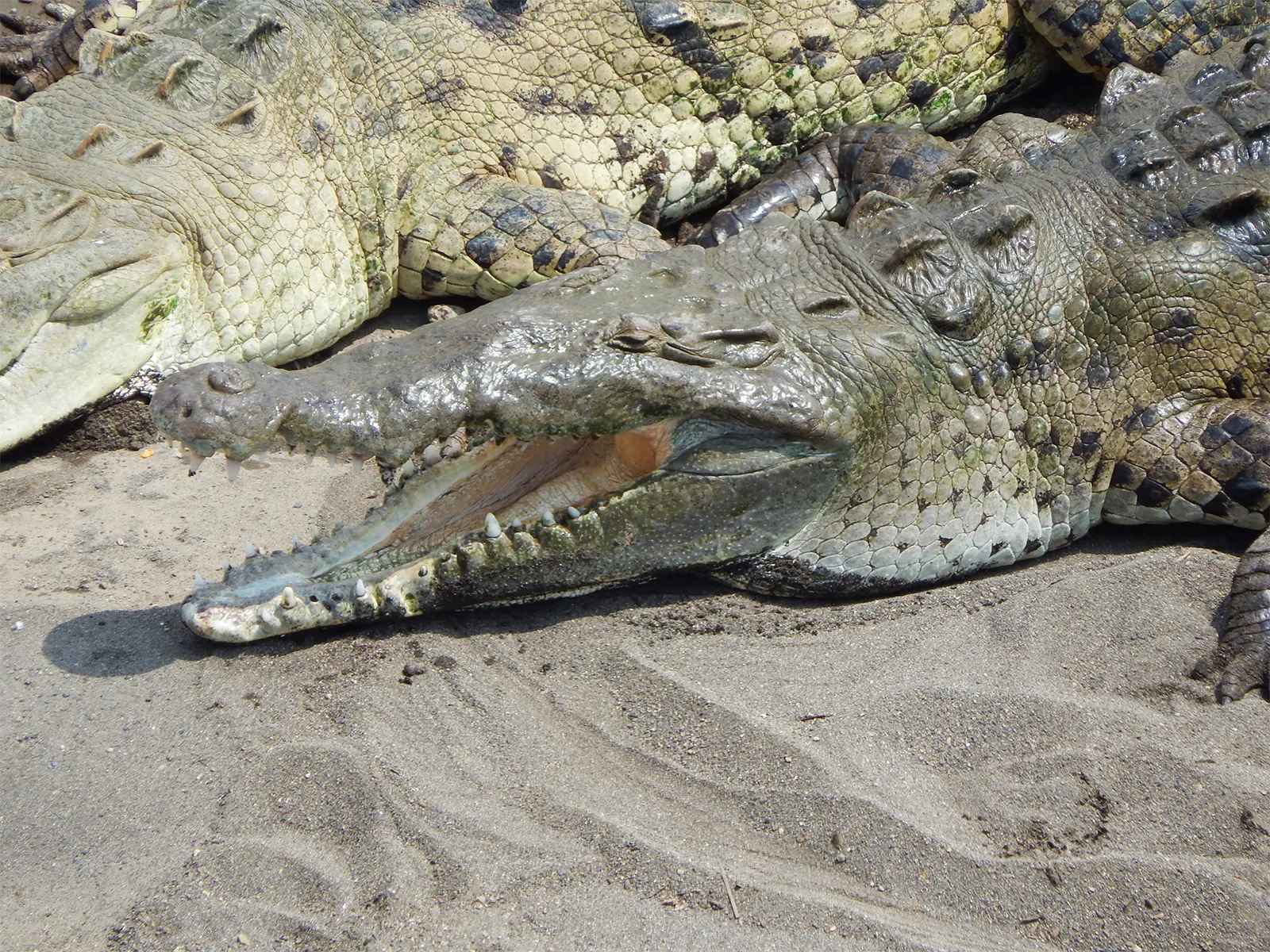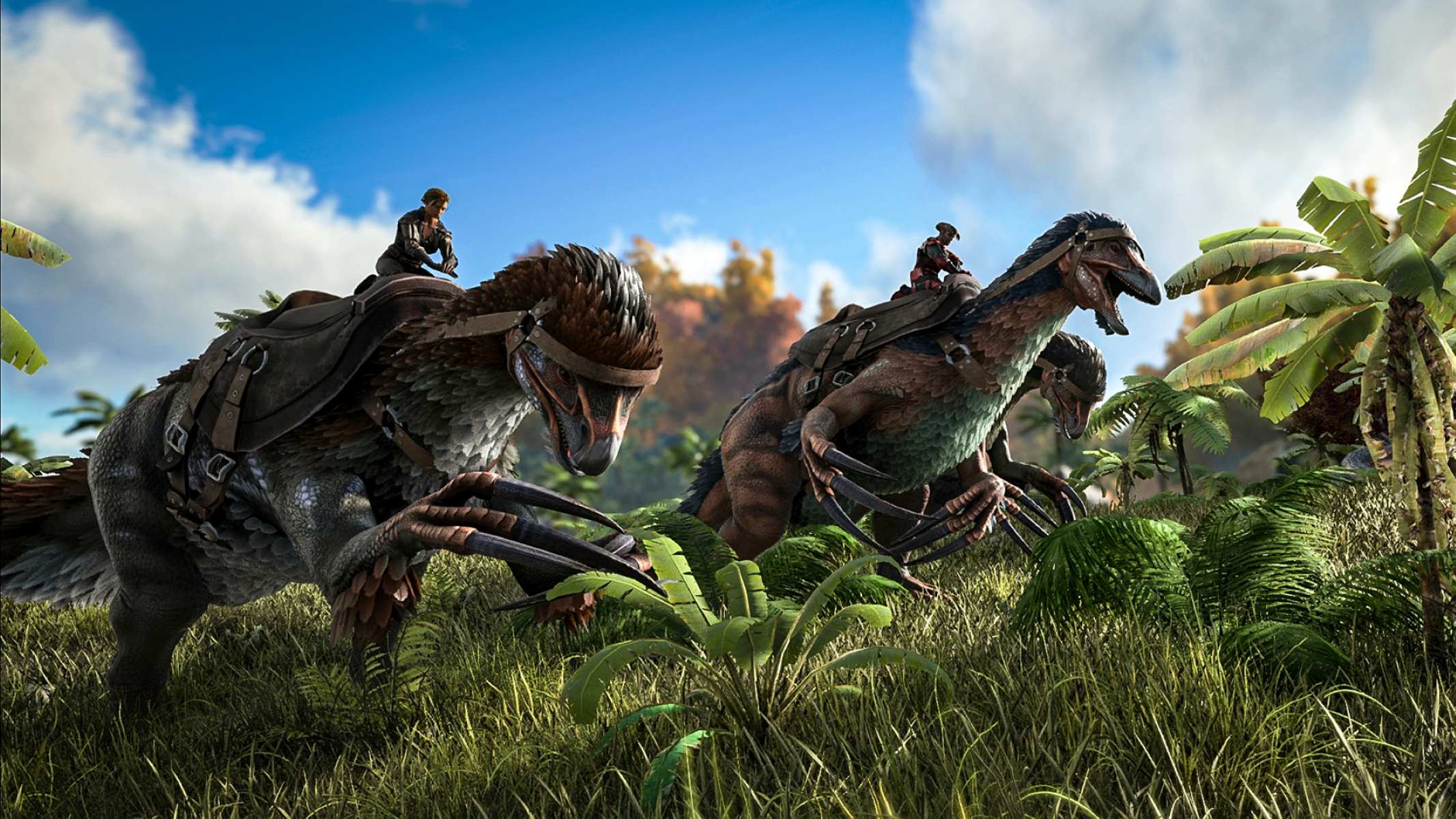Home>Pets & Animals>The Ultimate Guide To Differentiating Crocodiles, Caimans, Gharials, And Alligators


Pets & Animals
The Ultimate Guide To Differentiating Crocodiles, Caimans, Gharials, And Alligators
Published: February 6, 2024
Learn how to differentiate between crocodiles, caimans, gharials, and alligators with our comprehensive guide. Explore the unique characteristics of each species and discover fascinating facts about these captivating pets and animals.
(Many of the links in this article redirect to a specific reviewed product. Your purchase of these products through affiliate links helps to generate commission for Regretless.com, at no extra cost. Learn more)
Table of Contents
Introduction
The crocodile, caiman, gharial, and alligator are fascinating creatures that belong to the order Crocodylia, commonly known as crocodilians. While these reptiles share several similarities, they also possess distinct characteristics that set them apart from one another. Understanding the differences between these species is essential for appreciating their unique traits and behaviors.
Crocodiles, caimans, gharials, and alligators have captured the imagination of humans for centuries, featuring prominently in folklore, mythology, and popular culture. Their formidable appearance and ancient lineage have contributed to their status as both feared predators and revered symbols in various cultures around the world.
Despite their intimidating reputation, these creatures play crucial roles in their respective ecosystems, influencing the balance of aquatic food chains and contributing to the overall biodiversity of their habitats. As apex predators, they help regulate the populations of prey species, thereby exerting a significant impact on the ecological dynamics of their environments.
In this comprehensive guide, we will delve into the distinct physical characteristics, habitat preferences, feeding behaviors, reproductive strategies, conservation status, and interactions with humans of crocodiles, caimans, gharials, and alligators. By exploring the unique traits and ecological significance of these remarkable creatures, we can gain a deeper appreciation for their place in the natural world.
Through the exploration of their differences and similarities, we aim to provide a holistic understanding of these iconic reptiles, shedding light on their evolutionary adaptations, ecological roles, and the challenges they face in an increasingly human-dominated world. Join us on this captivating journey as we unravel the mysteries and marvels of crocodiles, caimans, gharials, and alligators.
Physical Characteristics
Crocodiles
- Crocodiles are large, aquatic reptiles with elongated, V-shaped snouts and visible fourth tooth when their mouths are closed.
- They have webbed feet, which aid in efficient swimming, and their powerful tails propel them through the water with remarkable agility.
- The skin of crocodiles is rough and covered in armored scales known as osteoderms, providing protection and thermal regulation.
- Their coloration varies, ranging from olive green to grayish-brown, enabling effective camouflage in their natural habitats.
- Adult crocodiles can grow to impressive sizes, with the saltwater crocodile holding the title for being the largest living reptile species.
Caimans
- Caimans are smaller in size compared to crocodiles, with broad, short snouts and often visible teeth when their jaws are shut.
- They possess a bony ridge between their eyes, contributing to their distinctive appearance, and their skin is covered in bony plates called scutes.
- Caimans are typically found in freshwater habitats, and their coloration varies from light tan to dark brown, aiding in concealment among aquatic vegetation.
- Their relatively compact size and robust build make them well-suited for navigating through densely vegetated areas and hunting small prey with precision.
Gharials
- Gharials are characterized by their long, narrow snouts, which are lined with numerous interlocking teeth, specifically adapted for catching fish.
- They have a distinct bulbous growth known as a ghara on the tip of their snouts, which is more prominent in mature males and serves as a vocal resonator.
- Gharials possess a slender body and a unique, elongated snout, making them highly specialized for an aquatic lifestyle and piscivorous feeding habits.
- Their coloration is predominantly olive to grayish-brown, and they are well adapted to life in fast-flowing rivers, where they can navigate with remarkable agility.
Alligators
- Alligators have broad, U-shaped snouts, with only their upper teeth being visible when their jaws are closed, distinguishing them from crocodiles.
- They exhibit a darker coloration compared to crocodiles, with dark gray to black skin, providing effective camouflage in the murky waters they inhabit.
- The skin of alligators is covered in large, bony plates called scutes, offering protection and contributing to their robust appearance.
- Alligators are well adapted to both freshwater and brackish environments, utilizing their powerful jaws and muscular tails to maneuver through their habitats with precision.
In summary, each species of crocodilian possesses unique physical characteristics that have evolved to suit their specific ecological niches, enabling them to thrive in diverse aquatic environments. Understanding these distinctions is crucial for appreciating the remarkable adaptations and ecological roles of crocodiles, caimans, gharials, and alligators.
Habitat and Distribution
Crocodiles, caimans, gharials, and alligators exhibit distinct habitat preferences and geographical distributions, reflecting their evolutionary adaptations to diverse aquatic environments across the globe.
Crocodiles
Crocodiles are found in a wide range of habitats, including freshwater rivers, lakes, marshes, and brackish estuaries. They are distributed across various continents, with species such as the Nile crocodile inhabiting the rivers and wetlands of sub-Saharan Africa, while the American crocodile is found in the coastal regions of the Americas. The saltwater crocodile, renowned for its impressive size and formidable presence, thrives in the brackish waters of Southeast Asia and Northern Australia. These resilient reptiles have demonstrated their ability to adapt to different environmental conditions, showcasing their remarkable versatility in occupying diverse aquatic landscapes.
Caimans
Caimans are primarily found in freshwater habitats, including slow-moving rivers, swamps, and wetlands throughout Central and South America. They are particularly abundant in the Amazon Basin, where their presence is integral to the intricate web of life within the region's extensive waterways and floodplains. Caimans' compact size and robust build enable them to navigate through densely vegetated areas, where they play a crucial role in regulating the populations of aquatic organisms, contributing to the overall ecological balance of their habitats.
Gharials
Gharials are specialized for life in fast-flowing rivers, particularly in the freshwater systems of the Indian subcontinent. They are predominantly found in the Ganges, Brahmaputra, Mahanadi, and Indus river basins, where their elongated snouts and streamlined bodies facilitate efficient movement through the water. The unique adaptations of gharials reflect their dependence on specific riverine habitats, emphasizing the importance of preserving these ecosystems to ensure the survival of these critically endangered reptiles.
Alligators
Alligators are primarily associated with freshwater environments, including swamps, marshes, and rivers, inhabiting regions of the southeastern United States and parts of China. The American alligator, in particular, has a widespread presence in the wetlands of Florida and Louisiana, where it plays a vital role in shaping the ecological dynamics of these unique ecosystems. Alligators' ability to thrive in diverse freshwater habitats underscores their significance as keystone species, influencing the structure and function of the ecosystems they inhabit.
In essence, the habitat preferences and distribution patterns of crocodiles, caimans, gharials, and alligators reflect their remarkable adaptability to a variety of aquatic landscapes. Understanding the geographical ranges and ecological requirements of these iconic reptiles is essential for implementing effective conservation strategies and safeguarding their continued existence in the face of environmental challenges.
Feeding Behavior
Crocodiles, caimans, gharials, and alligators are apex predators within their respective ecosystems, exhibiting distinct feeding behaviors that reflect their ecological roles as formidable hunters and regulators of aquatic food chains.
Crocodiles
Crocodiles are opportunistic feeders, preying on a diverse array of aquatic and terrestrial animals. Their diet typically includes fish, amphibians, reptiles, birds, and mammals, making them versatile predators capable of exploiting a wide range of prey resources. Crocodiles are known for their ambush hunting strategy, utilizing their stealth and patience to launch sudden, powerful attacks on unsuspecting prey. Their formidable jaws and muscular bodies enable them to overpower and subdue large prey, demonstrating their prowess as top-tier predators in aquatic environments.
Caimans
Caimans primarily feed on fish, crustaceans, insects, and small mammals, displaying a preference for aquatic prey due to their streamlined bodies and efficient swimming abilities. Their hunting techniques often involve lying in wait near the water's edge, where they can swiftly seize unsuspecting prey with remarkable agility. Caimans play a crucial role in regulating the populations of aquatic organisms, contributing to the overall balance of their freshwater habitats through their selective feeding habits.
Gharials
Gharials are specialized for piscivorous feeding, relying predominantly on fish as their primary source of sustenance. Their long, slender jaws and interlocking teeth are uniquely adapted for catching and consuming fish with precision. Gharials exhibit a distinctive hunting behavior, using their streamlined bodies to navigate through fast-flowing rivers, where they can swiftly capture fish propelled by the current. Their piscivorous diet underscores their significance as key players in maintaining the ecological integrity of riverine ecosystems.
Alligators
Alligators are opportunistic predators, preying on a variety of aquatic and terrestrial prey, including fish, turtles, birds, and mammals. Their hunting strategies often involve lurking near the water's surface, utilizing their keen senses to detect potential prey. Alligators are capable of launching explosive attacks with remarkable speed and power, showcasing their prowess as apex predators in their freshwater habitats. Their role in regulating the populations of prey species contributes to the overall balance of wetland ecosystems, highlighting their ecological significance.
In summary, the feeding behaviors of crocodiles, caimans, gharials, and alligators reflect their specialized adaptations as apex predators, shaping the ecological dynamics of their respective habitats through their selective feeding habits and formidable hunting abilities.
Reproduction
Reproduction is a pivotal aspect of the life cycle of crocodiles, caimans, gharials, and alligators, playing a crucial role in sustaining their populations and ensuring the continuity of their species. These remarkable reptiles exhibit fascinating reproductive strategies and behaviors that are intricately linked to their ecological roles and the dynamics of their aquatic habitats.
Crocodiles
Crocodiles engage in elaborate courtship rituals and nesting behaviors, with the female crocodile constructing mound nests in suitable locations near the water's edge. The process of nest building involves the female excavating a mound of vegetation and soil, creating a warm and protective environment for her eggs. After laying her eggs, the female diligently guards the nest, regulating the temperature and moisture levels essential for the development of the embryos. Once the eggs hatch, the female assists the hatchlings in reaching the water, where they begin their journey to independence.
Caimans
Caimans also exhibit nesting behaviors, with the female constructing mound nests or utilizing existing vegetation to create suitable nesting sites. The female caiman lays her eggs in the carefully constructed nest, and like crocodiles, she diligently guards the nest, ensuring the optimal conditions for the development of the embryos. Upon hatching, the hatchlings receive maternal care and protection, remaining in close proximity to their mother as they acclimate to their aquatic environment.
Gharials
Gharials employ unique nesting behaviors, with the female excavating nest cavities in sandbanks along river shores. This nesting strategy provides a secure and well-ventilated environment for the eggs, safeguarding them from potential predators and environmental fluctuations. The female gharial closely monitors the nest, displaying remarkable dedication to ensuring the successful incubation of her eggs. After hatching, the female assists the hatchlings in reaching the water, where they begin their aquatic journey under her vigilant guidance.
Alligators
Alligators display nesting behaviors similar to those of crocodiles and caimans, with the female constructing mound nests in suitable locations within their freshwater habitats. The female alligator carefully tends to her nest, regulating the temperature and moisture levels essential for the development of the eggs. Once the eggs hatch, the female provides protection and guidance to the hatchlings, ensuring their safe transition into the aquatic environment.
In essence, the reproductive behaviors of crocodiles, caimans, gharials, and alligators exemplify their remarkable parental care and dedication to ensuring the survival of their offspring. These behaviors are intricately linked to the ecological dynamics of their habitats, contributing to the resilience and continuity of these iconic reptiles in their respective ecosystems.
Conservation Status
The conservation status of crocodiles, caimans, gharials, and alligators is a critical concern, reflecting the complex interplay between human activities, habitat loss, poaching, and the overarching need for effective conservation measures to safeguard these iconic reptiles.
Crocodiles
Several species of crocodiles are classified as vulnerable or endangered, facing significant threats due to habitat destruction, human-wildlife conflict, and illegal hunting. The American crocodile, for instance, is listed as vulnerable, with habitat degradation and human encroachment posing substantial challenges to its survival. Similarly, the Philippine crocodile and the Siamese crocodile are classified as critically endangered, highlighting the urgent need for conservation efforts to prevent their extinction.
Caimans
While some species of caimans are relatively abundant in their natural habitats, such as the spectacled caiman, others, like the black caiman, face heightened conservation concerns. Habitat fragmentation and overexploitation for their skin and meat have contributed to the decline of certain caiman populations, necessitating targeted conservation initiatives to mitigate these threats and ensure the long-term viability of these species.
Gharials
Gharials are among the most critically endangered crocodilians, with their populations severely depleted due to habitat degradation, river damming, and incidental capture in fishing gear. The conservation status of gharials reflects the urgent need for comprehensive habitat protection, captive breeding programs, and community-based conservation efforts to reverse their decline and facilitate their recovery in their native riverine ecosystems.
Alligators
The American alligator, while no longer listed as endangered, has faced significant conservation challenges in the past, primarily due to overhunting and habitat loss. Conservation measures, including habitat restoration and regulated hunting practices, have contributed to the recovery of alligator populations in certain regions. However, ongoing vigilance and sustainable management practices are essential to ensure the continued well-being of these iconic reptiles.
In response to the conservation challenges facing crocodiles, caimans, gharials, and alligators, numerous organizations, conservationists, and governmental agencies have implemented initiatives aimed at protecting these species and their habitats. These efforts encompass habitat restoration, anti-poaching measures, public awareness campaigns, and research programs focused on understanding the ecological requirements and population dynamics of these reptiles.
The conservation status of crocodilians underscores the importance of collaborative, science-based conservation strategies that integrate the needs of local communities and the imperative of preserving these iconic species for future generations. By addressing the complex array of threats facing crocodiles, caimans, gharials, and alligators, we can strive to ensure their enduring presence in the world's aquatic ecosystems, contributing to the rich tapestry of biodiversity and ecological balance.
The conservation status of crocodiles, caimans, gharials, and alligators necessitates sustained efforts to mitigate the threats they face and secure their rightful place in the natural world.
Interactions with Humans
The interactions between crocodiles, caimans, gharials, and alligators and humans have been marked by a complex interplay of fear, fascination, and conflict throughout history. These iconic reptiles, with their formidable presence and powerful predatory capabilities, have captured the human imagination, featuring prominently in folklore, mythology, and cultural symbolism. While revered in certain cultures as symbols of strength and resilience, these creatures have also instilled fear and caution due to their potential threat to human safety and livelihoods.
Human activities have significantly impacted the habitats and populations of crocodilians, leading to various forms of interactions that have shaped the conservation and management of these species. Historically, crocodiles and alligators have been hunted for their valuable hides, meat, and other body parts, driving several species to the brink of extinction. Overexploitation, combined with habitat destruction and human-wildlife conflict, has posed substantial challenges to the survival of these reptiles in the face of expanding human populations and land-use changes.
In regions where crocodiles, caimans, gharials, and alligators coexist with human communities, conflicts often arise due to predation on livestock, occasional attacks on humans, and competition for resources. These conflicts have sparked efforts to implement mitigation measures, such as the construction of protective barriers around human settlements, the establishment of crocodile management programs, and community-based conservation initiatives aimed at fostering coexistence and minimizing human-crocodilian conflicts.
Furthermore, the economic value of crocodilian products, such as leather and meat, has led to the development of sustainable use practices and captive breeding programs, offering alternative livelihood opportunities for local communities while promoting the conservation of these species. Additionally, ecotourism centered around crocodile and alligator viewing has emerged as a means to generate revenue and raise awareness about the ecological importance of these reptiles, fostering a sense of appreciation and stewardship among local populations and visitors.
Education and outreach initiatives have played a crucial role in enhancing public understanding of crocodilians, dispelling myths, and fostering a sense of coexistence and respect for these remarkable creatures. By promoting knowledge about the ecological roles of crocodiles, caimans, gharials, and alligators, as well as the importance of conserving their habitats, these efforts have contributed to fostering positive attitudes and behaviors toward these species among local communities and the broader public.
In essence, the interactions between crocodilians and humans reflect a complex tapestry of challenges, opportunities, and evolving attitudes toward these iconic reptiles. By promoting coexistence, sustainable management practices, and community engagement, we can strive to ensure the harmonious cohabitation of humans and crocodilians, fostering a shared appreciation for the vital roles these creatures play in the world's aquatic ecosystems.
Conclusion
In conclusion, the diverse world of crocodiles, caimans, gharials, and alligators offers a captivating glimpse into the intricate tapestry of nature's evolutionary marvels. These iconic reptiles, with their formidable presence and specialized adaptations, embody the resilience and magnificence of the natural world. By delving into their distinct physical characteristics, habitat preferences, feeding behaviors, reproductive strategies, conservation status, and interactions with humans, we gain a profound appreciation for the integral roles they play in shaping aquatic ecosystems and the broader ecological landscape.
The exploration of their physical traits reveals the remarkable adaptations that have evolved over millions of years, equipping them to thrive in diverse aquatic environments. From the formidable jaws of crocodiles to the streamlined bodies of gharials, each species exhibits unique features that reflect their ecological niches and predatory prowess. Understanding these physical distinctions is crucial for recognizing the intricate web of life in which they are intricately woven.
Furthermore, their habitat preferences and distribution patterns underscore the intricate relationship between these reptiles and the aquatic landscapes they call home. From the freshwater rivers of the Amazon Basin to the fast-flowing waters of the Indian subcontinent, crocodiles, caimans, gharials, and alligators have carved out niches that reflect their remarkable adaptability and ecological significance.
The feeding behaviors of these reptiles exemplify their roles as apex predators, shaping the dynamics of aquatic food chains and contributing to the overall balance of their habitats. Their selective feeding habits and hunting strategies underscore their influence on the ecological integrity of freshwater ecosystems, highlighting their significance as keystone species within their respective environments.
The reproductive behaviors of crocodilians reflect the intricate bond between parental care, ecological dynamics, and the continuity of their species. The dedication of females to nurturing their offspring and ensuring their successful transition into the aquatic environment underscores the resilience and adaptability of these iconic reptiles.
The conservation status of crocodiles, caimans, gharials, and alligators underscores the urgent need for collaborative, science-based initiatives aimed at safeguarding their populations and habitats. By addressing the complex array of threats they face, we can strive to ensure their enduring presence in the world's aquatic ecosystems, contributing to the rich tapestry of biodiversity and ecological balance.
In essence, the exploration of crocodiles, caimans, gharials, and alligators offers a profound insight into the intricate web of life, underscoring the imperative of preserving these iconic reptiles for future generations. By fostering a shared appreciation for their ecological significance and promoting coexistence with human communities, we can work toward a harmonious future where these remarkable creatures continue to thrive in the world's aquatic realms.









